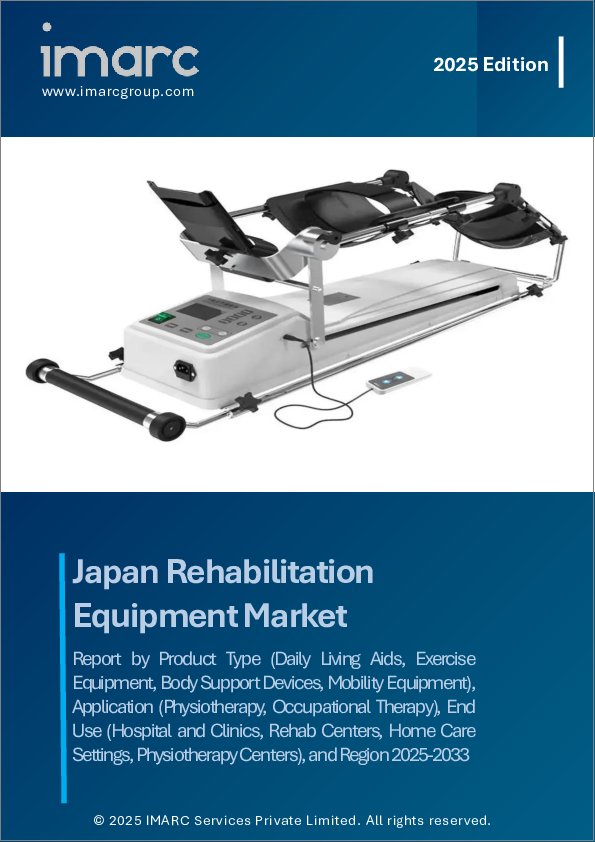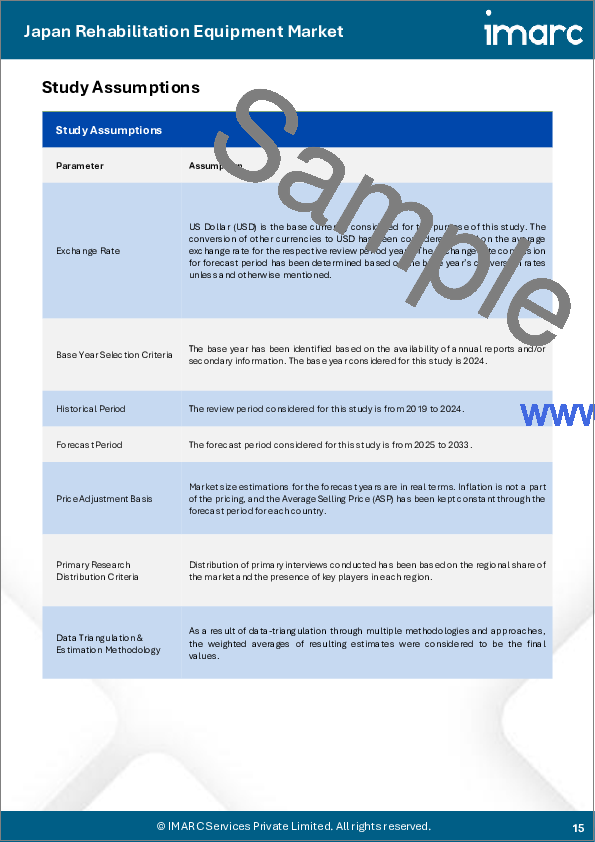|
|
市場調査レポート
商品コード
1729391
日本のリハビリ機器市場レポート:製品タイプ、用途、最終用途、地域別、2025年~2033年Japan Rehabilitation Equipment Market Report by Product Type, Application, End Use, and Region 2025-2033 |
||||||
カスタマイズ可能
|
|||||||
| 日本のリハビリ機器市場レポート:製品タイプ、用途、最終用途、地域別、2025年~2033年 |
|
出版日: 2025年05月01日
発行: IMARC
ページ情報: 英文 118 Pages
納期: 5~7営業日
|
全表示
- 概要
- 目次
日本のリハビリ機器の市場規模は2024年に6億7,950万米ドルに達しました。今後、IMARC Groupは、市場は2033年までに12億6,120万米ドルに達し、2025-2033年の成長率(CAGR)は6.58%になると予測しています。遠隔ヘルスケアプログラムの採用増加とともに、機器と臨床結果の強化に対するニーズの高まりが、主に市場成長の原動力となっています。
本レポートで扱う主な質問
- 日本のリハビリ機器市場はこれまでどのように推移し、今後どのように推移するのか?
- COVID-19が日本のリハビリ機器市場に与えた影響は?
- 日本のリハビリ機器市場の製品タイプ別区分は?
- 日本のリハビリ機器市場の用途別区分は?
- 日本のリハビリ機器市場の最終用途別の区分は?
- 日本のリハビリ機器市場のバリューチェーンにおける様々なステージとは?
- 日本のリハビリ機器の主な促進要因と課題は何か?
- 日本のリハビリ機器市場の構造と主要プレーヤーは?
- 日本のリハビリ機器市場における競合の程度は?
目次
第1章 序文
第2章 調査範囲と調査手法
- 調査の目的
- ステークホルダー
- データソース
- 市場推定
- 調査手法
第3章 エグゼクティブサマリー
第4章 日本のリハビリ機器市場:イントロダクション
- 概要
- 市場力学
- 業界動向
- 競合情報
第5章 日本のリハビリ機器市場情勢
- 過去および現在の市場動向(2019~2024年)
- 市場予測(2025~2033年)
第6章 日本のリハビリ機器市場:製品タイプ別の内訳
- 日常生活補助具
- 運動器具
- 身体サポート装置
- 移動用機器
第7章 日本のリハビリ機器市場:用途別の内訳
- 理学療法
- 作業療法
第8章 日本のリハビリ機器市場:最終用途別の内訳
- 病院と診療所
- リハビリセンター
- 在宅ケア環境
- 理学療法センター
第9章 日本のリハビリ機器市場:競合情勢
- 概要
- 市場構造
- 市場企業のポジショニング
- 主要成功戦略
- 競合ダッシュボード
- 企業評価象限
第10章 主要企業のプロファイル
第11章 日本のリハビリ機器市場:業界分析
- 促進要因、抑制要因、機会
- ポーターのファイブフォース分析
- バリューチェーン分析
第12章 付録
Japan rehabilitation equipment market size reached USD 679.5 Million in 2024. Looking forward, IMARC Group expects the market to reach USD 1,261.2 Million by 2033, exhibiting a growth rate (CAGR) of 6.58% during 2025-2033. The rising need for enhanced equipment and clinical outcomes, along with the increasing adoption of remote healthcare programs, is primarily driving the market growth.
Rehabilitation involves a range of interventions aimed at maximizing or reinstating human capabilities through a combination of training, therapies, and medicinal approaches. Rehabilitation equipment commonly include devices for mobility, walking assistance, body support, therapy, and continuous passive motion (CPM). These tools are utilized to prevent secondary disabilities, enhance flexibility, strengthen muscles, and improve overall physical attributes such as strength, coordination, and endurance. In addition to this, by doing so, they contribute to reducing the risk of both mental and physical complications. Consequently, rehabilitation equipment find widespread application in physiotherapy and occupational therapy procedures.
Japan Rehabilitation Equipment Market Trends:
The Japan rehabilitation equipment market is experiencing substantial growth driven by several influential factors. Notably, the increasing prevalence of various chronic and non-communicable diseases like cancer, arthritis, and Parkinson's, particularly among the aging population, has led to extensive utilization of rehabilitation equipment across various healthcare settings including clinics, hospitals, home care, and rehabilitation centers, which is positively influencing the regional market. Furthermore, the outbreak of the COVID-19 pandemic prompted the adoption of virtual and remote healthcare programs on online platforms, thereby acting as another significant growth-inducing factor. This shift has further enabled patients to access personalized training and medication, as well as share diagnostic records with rehabilitation professionals, further bolstering market growth. Moreover, to meet the surging demand for enhanced equipment and clinical outcomes, key market players are actively collaborating with other companies to introduce cost-effective, durable, and high-performance rehabilitation equipment, thus contributing to market expansion in Japan. Additionally, increased investments in research and development (R&D) activities, rising consumer healthcare expenditure, and various supportive initiatives by government and non-government organizations aimed at strengthening healthcare infrastructure are also collectively creating a positive outlook for the rehabilitation equipment market in Japan. These factors combined suggest a promising future for the market in the country.
Japan Rehabilitation Equipment Market Segmentation:
Product Type Insights:
- Daily Living Aids
- Medical Beds
- Bathroom and Toilet Assist Devices
- Reading Writing and Computer Aids
- Others
- Exercise Equipment
- Upper Body Exercise Equipment
- Lower Body Exercise Equipment
- Body Support Devices
- Patient Lifts
- Medical Lifting Slings
- Mobility Equipment
- Walking Assist Devices
- Wheelchairs and Scooters
Application Insights:
- Physiotherapy
- Occupational Therapy
End Use Insights:
- Hospital and Clinics
- Rehab Centers
- Home Care Settings
- Physiotherapy Centers
Competitive Landscape:
The market research report has also provided a comprehensive analysis of the competitive landscape. Competitive analysis such as market structure, key player positioning, top winning strategies, competitive dashboard, and company evaluation quadrant has been covered in the report. Also, detailed profiles of all major companies have been provided.
Key Questions Answered in This Report:
- How has the Japan rehabilitation equipment market performed so far and how will it perform in the coming years?
- What has been the impact of COVID-19 on the Japan rehabilitation equipment market?
- What is the breakup of the Japan rehabilitation equipment market on the basis of product type?
- What is the breakup of the Japan rehabilitation equipment market on the basis of application?
- What is the breakup of the Japan rehabilitation equipment market on the basis of end use?
- What are the various stages in the value chain of the Japan rehabilitation equipment market?
- What are the key driving factors and challenges in the Japan rehabilitation equipment?
- What is the structure of the Japan rehabilitation equipment market and who are the key players?
- What is the degree of competition in the Japan rehabilitation equipment market?
Table of Contents
1 Preface
2 Scope and Methodology
- 2.1 Objectives of the Study
- 2.2 Stakeholders
- 2.3 Data Sources
- 2.3.1 Primary Sources
- 2.3.2 Secondary Sources
- 2.4 Market Estimation
- 2.4.1 Bottom-Up Approach
- 2.4.2 Top-Down Approach
- 2.5 Forecasting Methodology
3 Executive Summary
4 Japan Rehabilitation Equipment Market - Introduction
- 4.1 Overview
- 4.2 Market Dynamics
- 4.3 Industry Trends
- 4.4 Competitive Intelligence
5 Japan Rehabilitation Equipment Market Landscape
- 5.1 Historical and Current Market Trends (2019-2024)
- 5.2 Market Forecast (2025-2033)
6 Japan Rehabilitation Equipment Market - Breakup by Product Type
- 6.1 Daily Living Aids
- 6.1.1 Overview
- 6.1.2 Historical and Current Market Trends (2019-2024)
- 6.1.3 Market Segmentation
- 6.1.3.1 Medical Beds
- 6.1.3.2 Bathroom and Toilet Assist Devices
- 6.1.3.3 Reading Writing and Computer Aids
- 6.1.3.4 Others
- 6.1.4 Market Forecast (2025-2033)
- 6.2 Exercise Equipment
- 6.2.1 Overview
- 6.2.2 Historical and Current Market Trends (2019-2024)
- 6.2.3 Market Segmentation
- 6.2.3.1 Upper Body Exercise Equipment
- 6.2.3.2 Lower Body Exercise Equipment
- 6.2.4 Market Forecast (2025-2033)
- 6.3 Body Support Devices
- 6.3.1 Overview
- 6.3.2 Historical and Current Market Trends (2019-2024)
- 6.3.3 Market Segmentation
- 6.3.3.1 Patient Lifts
- 6.3.3.2 Medical Lifting Slings
- 6.3.4 Market Forecast (2025-2033)
- 6.4 Mobility Equipment
- 6.4.1 Overview
- 6.4.2 Historical and Current Market Trends (2019-2024)
- 6.4.3 Market Segmentation
- 6.4.3.1 Walking Assist Devices
- 6.4.3.2 Wheelchairs and Scooters
- 6.4.4 Market Forecast (2025-2033)
7 Japan Rehabilitation Equipment Market - Breakup by Application
- 7.1 Physiotherapy
- 7.1.1 Overview
- 7.1.2 Historical and Current Market Trends (2019-2024)
- 7.1.3 Market Forecast (2025-2033)
- 7.2 Occupational Therapy
- 7.2.1 Overview
- 7.2.2 Historical and Current Market Trends (2019-2024)
- 7.2.3 Market Forecast (2025-2033)
8 Japan Rehabilitation Equipment Market - Breakup by End Use
- 8.1 Hospital and Clinics
- 8.1.1 Overview
- 8.1.2 Historical and Current Market Trends (2019-2024)
- 8.1.3 Market Forecast (2025-2033)
- 8.2 Rehab Centers
- 8.2.1 Overview
- 8.2.2 Historical and Current Market Trends (2019-2024)
- 8.2.3 Market Forecast (2025-2033)
- 8.3 Home Care Settings
- 8.3.1 Overview
- 8.3.2 Historical and Current Market Trends (2019-2024)
- 8.3.3 Market Forecast (2025-2033)
- 8.4 Physiotherapy Centers
- 8.4.1 Overview
- 8.4.2 Historical and Current Market Trends (2019-2024)
- 8.4.3 Market Forecast (2025-2033)
9 Japan Rehabilitation Equipment Market - Competitive Landscape
- 9.1 Overview
- 9.2 Market Structure
- 9.3 Market Player Positioning
- 9.4 Top Winning Strategies
- 9.5 Competitive Dashboard
- 9.6 Company Evaluation Quadrant
10 Profiles of Key Players
- 10.1 Company A
- 10.1.1 Business Overview
- 10.1.2 Product Portfolio
- 10.1.3 Business Strategies
- 10.1.4 SWOT Analysis
- 10.1.5 Major News and Events
- 10.2 Company B
- 10.2.1 Business Overview
- 10.2.2 Product Portfolio
- 10.2.3 Business Strategies
- 10.2.4 SWOT Analysis
- 10.2.5 Major News and Events
- 10.3 Company C
- 10.3.1 Business Overview
- 10.3.2 Product Portfolio
- 10.3.3 Business Strategies
- 10.3.4 SWOT Analysis
- 10.3.5 Major News and Events
- 10.4 Company D
- 10.4.1 Business Overview
- 10.4.2 Product Portfolio
- 10.4.3 Business Strategies
- 10.4.4 SWOT Analysis
- 10.4.5 Major News and Events
- 10.5 Company E
- 10.5.1 Business Overview
- 10.5.2 Product Portfolio
- 10.5.3 Business Strategies
- 10.5.4 SWOT Analysis
- 10.5.5 Major News and Events
11 Japan Rehabilitation Equipment Market - Industry Analysis
- 11.1 Drivers, Restraints and Opportunities
- 11.1.1 Overview
- 11.1.2 Drivers
- 11.1.3 Restraints
- 11.1.4 Opportunities
- 11.2 Porters Five Forces Analysis
- 11.2.1 Overview
- 11.2.2 Bargaining Power of Buyers
- 11.2.3 Bargaining Power of Suppliers
- 11.2.4 Degree of Competition
- 11.2.5 Threat of New Entrants
- 11.2.6 Threat of Substitutes
- 11.3 Value Chain Analysis






